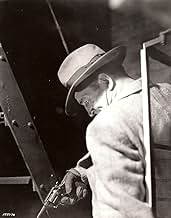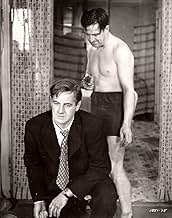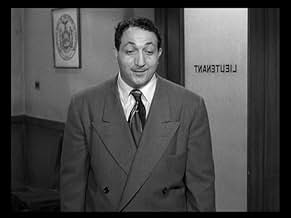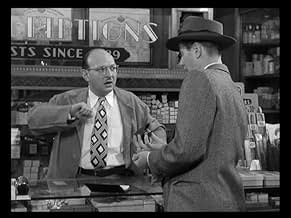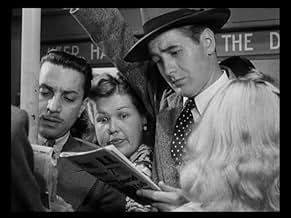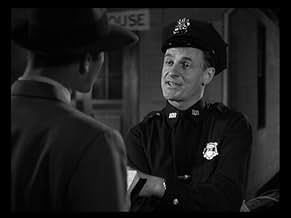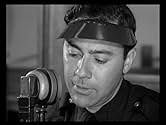AVALIAÇÃO DA IMDb
7,5/10
17 mil
SUA AVALIAÇÃO
Um olhar passo a passo sobre uma investigação de assassinato nas ruas de Nova Iorque.Um olhar passo a passo sobre uma investigação de assassinato nas ruas de Nova Iorque.Um olhar passo a passo sobre uma investigação de assassinato nas ruas de Nova Iorque.
- Direção
- Roteiristas
- Artistas
- Ganhou 2 Oscars
- 6 vitórias e 5 indicações no total
Ted de Corsia
- Willy Garzah
- (as Ted De Corsia)
Mark Hellinger
- Narrator
- (narração)
Jean Adair
- Little Old Lady
- (não creditado)
Celia Adler
- Dress Shop Proprietress
- (não creditado)
Janie Alexander
- Girl
- (não creditado)
Joyce Allen
- Shopgirl
- (não creditado)
Beverly Bayne
- Mrs. Stoneman
- (não creditado)
Avaliações em destaque
That's just what the producer, Mark Hellinger does. He tries to make it clear from the introduction that this is not your average movie. It is not. This entire production tries to accomplish one thing - authenticity. And for the most part, it succeeds.
Before I get to what's right about this movie, let me mention a few of the things that are wrong. Ted DeCorsia overacts. He always overacts. Howard Duff's character, Frankie Niles, is supposed to be a streetwise grifter. How the hell could he be dumb enough to get himself in as many pickles as he did. Anybody who has ever been around the block would know better than to lie to the cops about everything. Just lie about the important things and tell the truth when it won't hurt you. If this guy is a sociopath, he's the dumbest one in town. Although most of the accents are on the money, the incidental dialogue injected into some of the scenes sounds forced and phony. In fact, it sounds like Hollywood trying to sound like New York. Mark Hellinger's narration, by comparison, is not only authentic, it's practically Damon Runyonesque.
Now - what's right. Practically everything else. The location photography is the New York I remember as a kid. While I was watching some of the hot summer scenes downtown, I could practically smell the asphalt, melting tar, and garbage. Don Taylor's brick duplex in Queens was just the kind of house that every struggling family on the wrong side of Brooklyn aspired to.
I won't comment on the story except to say, it's an entirely believable crime story. I seem to remember Barry Fitzgerald playing a similar role in Union Station. Reminds one of the old days when most of the cops were Irish - and New York was really New York.
Before I get to what's right about this movie, let me mention a few of the things that are wrong. Ted DeCorsia overacts. He always overacts. Howard Duff's character, Frankie Niles, is supposed to be a streetwise grifter. How the hell could he be dumb enough to get himself in as many pickles as he did. Anybody who has ever been around the block would know better than to lie to the cops about everything. Just lie about the important things and tell the truth when it won't hurt you. If this guy is a sociopath, he's the dumbest one in town. Although most of the accents are on the money, the incidental dialogue injected into some of the scenes sounds forced and phony. In fact, it sounds like Hollywood trying to sound like New York. Mark Hellinger's narration, by comparison, is not only authentic, it's practically Damon Runyonesque.
Now - what's right. Practically everything else. The location photography is the New York I remember as a kid. While I was watching some of the hot summer scenes downtown, I could practically smell the asphalt, melting tar, and garbage. Don Taylor's brick duplex in Queens was just the kind of house that every struggling family on the wrong side of Brooklyn aspired to.
I won't comment on the story except to say, it's an entirely believable crime story. I seem to remember Barry Fitzgerald playing a similar role in Union Station. Reminds one of the old days when most of the cops were Irish - and New York was really New York.
...New York! This film is presented as a quasi-documentary (it is not). Though the story is fictional, the setting is entirely real - 1948 New York City. And that is the biggest appeal of the picture (I was born and raised there so I may be biased). Some interior shots appear to have been filmed on a sound stage, but the bulk of it is on location. For example, there is a scene filmed in lower Manhattan near Rivington and Norfolk streets. It show's a bustling, thriving "family" neighborhood with well dressed folks and kids playing in the neighborhood. It looks nothing like that now - just a place to pass through to get to somewhere else (though there is a school there now - check google maps and find the intersection - you can see the same building in the opening shot for that scene).
Story-wise, it's a pretty solid film especially considering how dated movies from this period can be. There appears to be a real attempt to make the movie as accurate as possible and goes out of its way to include the methods used in solving modern crimes such as forensics - probably a novelty at the time. The acting is solid throughout. I'm not sure how comfortable I am with the idea of a narrator - on the one hand, it lends authenticity to the documentary feel, but on the other, it can take you "out" of the picture at times. Overall, very worth watching. I give it a thumbs up (can I do that here?)
Story-wise, it's a pretty solid film especially considering how dated movies from this period can be. There appears to be a real attempt to make the movie as accurate as possible and goes out of its way to include the methods used in solving modern crimes such as forensics - probably a novelty at the time. The acting is solid throughout. I'm not sure how comfortable I am with the idea of a narrator - on the one hand, it lends authenticity to the documentary feel, but on the other, it can take you "out" of the picture at times. Overall, very worth watching. I give it a thumbs up (can I do that here?)
An unrealized project of Alfred Hitchcock's was to make a movie about 24 hours in the life of a great city, probably New York. Producer Mark Hellinger enlisted director Jules Dassin to attempt a similar stunt. The result was The Naked City, a slice-of-life police procedural that served as template for the popular television series a decade later. And while the movie is nowhere near the ground-breaking cinematic enterprise that Hellinger promises in his introduction and ceaseless voice-over narration, it's not negligible. With its huge cast (many of them recognizable, even in mute or walk-on roles) and pioneering location shooting on the sidewalks of New York during the sweltering summer of 1947, it nonetheless continues to satisfy. Its documentary aspect outlives its suspense plot.
It opens with two men chloroforming and then drowning a high-profile model in her city apartment (shades of I Wake Up Screaming and Laura). When her cleaning lady finds her next morning, it falls to Detective Lieutenant Barry Fitzgerald, with his heather-honey lilt, and his principal investigator, Don Taylor, to fit the pieces together. Soon into their web flits Howard Duff, an affable, educated loafer with no visible means of support who lies even when the truth would do him no harm. It seems he was on cozy terms with the deceased, even though he's engaged to one of her co-workers (Dorothy Hart). But although Duff's a poor excuse for a human being, nothing seems to stick to him, either. So the police slog on through the broiling day and soupy night, knocking on doors and flashing pictures of the dead girl. Their sleuthing takes them, and us, up and down the hierarchy of the city's eight million souls, from society dames and society doctors to street vendors and street crazies.
While the plot never rises out of the routine, these urban excursions give the movie its raffish texture and remain one of its chief pleasures. This was New York in the dawn of its post-war effloresence, a city where it was still common practice to live comfortably on modest average wages. The gap between East Side apartments and Lower East Side walkups, with the bathtub in the kitchen, doesn't yet seem impossible to cross. And its inhabitants burst on camera with a welter of accents and attitudes. Hellinger and Dassin must have enlisted the services of every character-actor and bit-player in the Tri-State area, and film buffs will have a trivia tournament in trying to pick them out.
The Naked City ends with a chase over hot pavements and a stand-off high up on one of the bridges spanning the East River. It's a great set-piece, of the sort that action movies are all but required to include, but the movie's strength proves more subtle it lies in its collection of sharply drawn vignettes (some of them, to be sure, little more than sentimental shtik). The Naked City is a rarity a major production where the day players outshine the stars.
It opens with two men chloroforming and then drowning a high-profile model in her city apartment (shades of I Wake Up Screaming and Laura). When her cleaning lady finds her next morning, it falls to Detective Lieutenant Barry Fitzgerald, with his heather-honey lilt, and his principal investigator, Don Taylor, to fit the pieces together. Soon into their web flits Howard Duff, an affable, educated loafer with no visible means of support who lies even when the truth would do him no harm. It seems he was on cozy terms with the deceased, even though he's engaged to one of her co-workers (Dorothy Hart). But although Duff's a poor excuse for a human being, nothing seems to stick to him, either. So the police slog on through the broiling day and soupy night, knocking on doors and flashing pictures of the dead girl. Their sleuthing takes them, and us, up and down the hierarchy of the city's eight million souls, from society dames and society doctors to street vendors and street crazies.
While the plot never rises out of the routine, these urban excursions give the movie its raffish texture and remain one of its chief pleasures. This was New York in the dawn of its post-war effloresence, a city where it was still common practice to live comfortably on modest average wages. The gap between East Side apartments and Lower East Side walkups, with the bathtub in the kitchen, doesn't yet seem impossible to cross. And its inhabitants burst on camera with a welter of accents and attitudes. Hellinger and Dassin must have enlisted the services of every character-actor and bit-player in the Tri-State area, and film buffs will have a trivia tournament in trying to pick them out.
The Naked City ends with a chase over hot pavements and a stand-off high up on one of the bridges spanning the East River. It's a great set-piece, of the sort that action movies are all but required to include, but the movie's strength proves more subtle it lies in its collection of sharply drawn vignettes (some of them, to be sure, little more than sentimental shtik). The Naked City is a rarity a major production where the day players outshine the stars.
This is a great Film Noir movie which I enjoyed very much. My favorite part is watching all the 100's of people on the streets on New York City not having a clue that the are immortalized in this motion picture. I love to freeze frame the street scenes and view how life was like in 1948. So many surprises, for example in the phone booth scene, notice the two men peering out the window in the store across the street. I think those guys were aware of the filming, but as the scene continued, they went back to serving their customers. Just plain magic. There is also a cool goof in this film. Note during the train station chase scene, just after Frank runs by, the director or a film crew member turns towards the camera and yells what I believe is "CUT"...So Fun....I'll see again and again and again!
There were quite a few reasons for wanting to see 'The Naked City'. Like Barry Fitzgerald in a lot of other films ('And Then There Were None' being my introduction to him and still consider his performance in that one of his best), though it was interesting to see him in a lead role rather than his relative usual supporting roles and an atypical one at that. Really like what has been seen so far of Jules Dassin's work, especially 'Night and the City'. Also wanted to see whether the film lived up to its highly influential reputation.
Good news is mostly 'The Naked City' does. One can see why 'The Naked City' was influential in its documentary style, which at the time and even by today's standards innovative, and how it is treated in a way that is driven by its characters and with an emphasis on the police and how they worked. And that makes it a highly interesting film and elevates that is fairly conventional, with familiar genre tropes, in the story department. Yet still makes a gripping film regardless of that.
Not many problems here, though for my tastes Don Taylor seemed bland and detached, not always looking very comfortable either.
Do think that the narration could have been used less, as some of it did not always feel needed.
Conversely, 'The Naked City' is immaculately photographed and New York, like its own character, is a major star here. The cinematography and editing Oscars were richly deserved. The haunting score adds hugely, as does Dassin's direction. Dassin is highly successful in creating an authentic, audacious and sometimes unsettling visual style. He is equally successful at keeping the story at a controlled, yet never in my mind mannered or tedious, way that sustains the suspense brilliantly.
Loved the layered tautness of the script outside of the narration, while the story is gripping and its intelligence, high suspense and a knockout of a final chase made me able to forgive that it was quite conventional. The opening sequence is a unique one. Outside of Taylor, didn't actually have an issue with the performances. Although an effective Fitzgerald has been widely talked about, on both sides of good and not so good (am in the former camp), for me the best performance came from chilling Ted De Corsia.
In conclusion, very good film and deservedly influential. 8/10
Good news is mostly 'The Naked City' does. One can see why 'The Naked City' was influential in its documentary style, which at the time and even by today's standards innovative, and how it is treated in a way that is driven by its characters and with an emphasis on the police and how they worked. And that makes it a highly interesting film and elevates that is fairly conventional, with familiar genre tropes, in the story department. Yet still makes a gripping film regardless of that.
Not many problems here, though for my tastes Don Taylor seemed bland and detached, not always looking very comfortable either.
Do think that the narration could have been used less, as some of it did not always feel needed.
Conversely, 'The Naked City' is immaculately photographed and New York, like its own character, is a major star here. The cinematography and editing Oscars were richly deserved. The haunting score adds hugely, as does Dassin's direction. Dassin is highly successful in creating an authentic, audacious and sometimes unsettling visual style. He is equally successful at keeping the story at a controlled, yet never in my mind mannered or tedious, way that sustains the suspense brilliantly.
Loved the layered tautness of the script outside of the narration, while the story is gripping and its intelligence, high suspense and a knockout of a final chase made me able to forgive that it was quite conventional. The opening sequence is a unique one. Outside of Taylor, didn't actually have an issue with the performances. Although an effective Fitzgerald has been widely talked about, on both sides of good and not so good (am in the former camp), for me the best performance came from chilling Ted De Corsia.
In conclusion, very good film and deservedly influential. 8/10
Você sabia?
- CuriosidadesMost of the street scenes were shot on location in New York without the public's knowledge. Photographer William H. Daniels and his uncredited assistant Roy Tripp filmed people on the streets using a hidden camera from the back of an old moving van. Occasionally, a fake newsstand with a hidden camera inside was also set up on the sidewalk to secretly film the actors. Director Jules Dassin hired a juggler to distract the crowds and also hired a man to occasionally climb up on a light post and give a patriotic speech, while waving an American flag to get the crowd's attention.
- Erros de gravaçãoDuring the end pursuit, Garzah walks past a plump, dark-haired lady in a floral dress, pushing a baby in a stroller. As Donahue pursues in a following scene, he passes the same woman, now walking without her baby carriage and her left hand bandaged.
- Cenas durante ou pós-créditosThe opening credits are spoken by producer/narrator Mark Hellinger. No credits are seen on the screen.
- ConexõesFeatured in The Movie Orgy (1968)
- Trilhas sonorasSobre las Olas (Over the Waves)
(1887) (uncredited)
Written by Juventino Rosas
Background music for the girls on swings
Principais escolhas
Faça login para avaliar e ver a lista de recomendações personalizadas
- How long is The Naked City?Fornecido pela Alexa
Detalhes
- Data de lançamento
- País de origem
- Idioma
- Também conhecido como
- La ciudad desnuda
- Locações de filme
- Empresas de produção
- Consulte mais créditos da empresa na IMDbPro
Bilheteria
- Faturamento bruto nos EUA e Canadá
- US$ 2.400.000
- Tempo de duração
- 1 h 36 min(96 min)
- Cor
- Proporção
- 1.37 : 1
Contribua para esta página
Sugerir uma alteração ou adicionar conteúdo ausente


